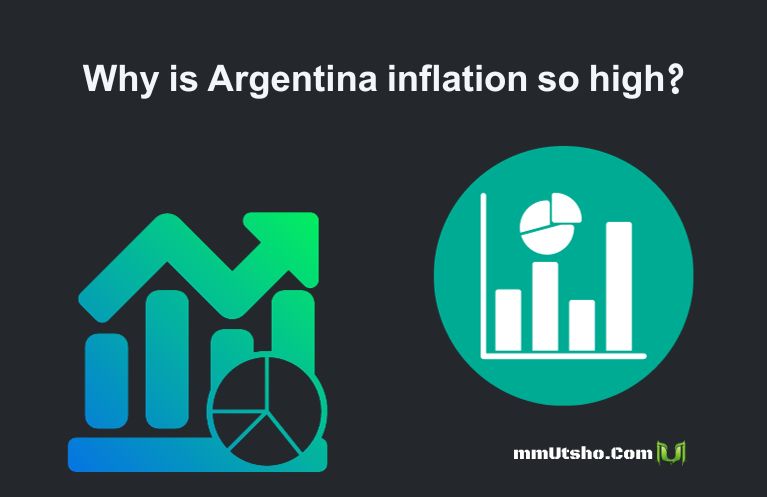Introduction:
Argentina, a vibrant South American nation renowned for its tango, football, and stunning landscapes, has unfortunately been grappling with a persistent economic challenge for decades – sky-high inflation. With its inflation rate continually surpassing global averages, it is crucial to delve deeper into the intricate factors that contribute to Argentina’s inflation conundrum. In this blog post, we will explore the reasons behind Argentina’s persistently high inflation rate, shedding light on a topic that demands attention and understanding.
Argentina Inflation: A Historical Perspective
To fully grasp the multifaceted challenge of Argentina’s inflation, one must trace its origins back through the country’s historical timeline. Argentina has grappled with persistent inflationary patterns since the mid-20th century. The issue of Argentina’s inflation is intricately linked to a complex web of historical elements, such as flawed fiscal policies, excessive government spending, and periods of political turmoil. This historical backdrop has not only perpetuated inflation but has also woven it into the very fabric of Argentine society.
Argentina’s economic policies have been profoundly marked by inadequate fiscal strategies and unsustainable spending by governments of the past. This economic history has significantly shaped the nation’s current state. The cyclical nature of inflation in Argentina, interwoven with historical decisions and socio-political circumstances, remains a defining factor in the country’s economic landscape. Understanding Argentina’s inflation conundrum involves a deep dive into its historical evolution, as this historical context remains instrumental in comprehending the complexities and nuances of the present-day economic challenges related to inflation in the country.
Impact of Currency Devaluation on Argentina’s Inflation
Argentina’s inflation is significantly influenced by the persistent issue of currency devaluation. The continuous devaluation of the peso impacts the economy, causing a surge in imported goods’ prices and reducing the competitiveness of local products globally. This places pressure on the central bank to increase the money supply, instigating inflation within the domestic market. The subsequent cycle exacerbates inflationary pressures, as increased costs of imports lead to higher production expenses and local goods’ prices. The ongoing challenge of currency devaluation and its impact on inflation creates a cyclical economic issue for Argentina, demanding a comprehensive understanding and strategic response to stabilize the nation’s economic landscape.
Fiscal Deficit and Government Mismanagement in Argentina
Continual fiscal deficits in Argentina highlight a persistent issue with government overspending. The consistent trend of expenditure surpassing revenue generation creates a substantial funding gap. To offset this gap, Argentina frequently turns to borrowing, both locally and globally. However, this heavy reliance on borrowing not only sparks Argentina’s inflation but also contributes to an escalating cycle of debt accumulation, further compounding the nation’s inflationary challenges.
The interconnection between Argentina’s fiscal imbalances, borrowing practices, and inflation in Argentina delineates a crucial economic challenge. This ongoing cycle poses a pressing need for the implementation of astute fiscal policies to mitigate the inflationary pressures, stabilize the economy, and curtail the mounting debt burden in the nation.
Wage-Price Spiral in Argentina
Furthermore, an amplified wage-price spiral plays a crucial role in driving Argentina’s persistently high inflation rate. This phenomenon stems from the destructive cycle where inflation erodes the purchasing power of individuals, prompting them to seek higher wages to maintain their living standards. Yet, the conundrum arises when wage increases occur without corresponding productivity improvements within the economy, leading firms to respond by raising prices. This interconnected cycle sets in motion a self-reinforcing loop, exacerbating Argentina’s inflation.
This wage-price spiral, characterized by the relentless upward pressure on both wages and prices, poses a formidable challenge for the nation. Breaking this cycle requires not only effective monetary policies but also substantial structural reforms aimed at enhancing productivity, reducing inflation expectations, and fostering economic stability. The interplay between inflation, wage dynamics, and price increases forms a complex web of factors that must be addressed comprehensively to tackle the persistent issue of Argentina’s inflation and restore long-term economic equilibrium.
Central Bank Independence and Argentina’s Inflation
The independence and credibility of the central bank are pivotal in effectively managing Argentina’s inflation. Over time, Argentina has encountered various instances of central bank intervention, which unfortunately brought about economic distortions. This history has contributed to an ongoing struggle to establish and solidify the central bank’s credibility, leading to prevalent market skepticism and a pervasive lack of trust. Consequently, this prevailing uncertainty fuels inflationary expectations, creating a challenging environment for the central bank to efficiently rein in and stabilize Argentina’s inflation.
This struggle to cement the central bank’s credibility is a critical hurdle in the fight against inflation in Argentina. Market confidence in the central bank’s ability to maintain price stability and economic balance is crucial. The lack of trust hampers the central bank’s efforts to implement effective policies that could curb inflationary pressures. Restoring faith and credibility in the central bank’s measures is essential to mitigate the adverse impact of inflationary expectations on the overall economic landscape and to foster sustainable economic stability in Argentina.
Conclusion:
The high inflation rate in Argentina is a multi-faceted issue stemming from a historical legacy of poor fiscal policies, currency devaluation, government mismanagement, wage-price spirals, and a lack of central bank independence. Addressing these complex factors demands a comprehensive approach, including prudent fiscal policies, structural reforms, bolstering central bank independence, and promoting investor confidence. By understanding and addressing these root causes, Argentina can pave the way towards sustainable economic growth, stability, and a brighter future for its citizens.
